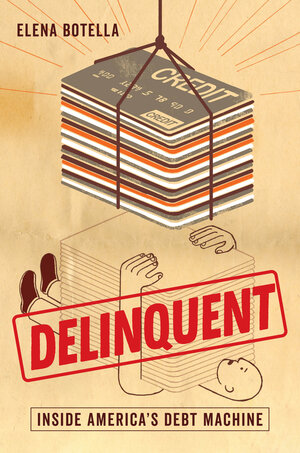
Delinquent takes readers on a journey from Capital One’s headquarters to street corners in Detroit, kitchen tables in Sacramento, and other places where debt affects people’s everyday lives. Uncovering the true costs of consumer credit to American families in addition to the benefits, investigative journalist Elena Botella—formerly an industry insider who helped set credit policy at Capital One—reveals the underhanded and often predatory ways that banks induce American borrowers into debt they can’t pay back.
Elena Botella was a Senior Business Manager at Capital One, where she ran the company’s Secured Card credit card and taught credit risk management. Her writing has appeared in The New Republic, Slate, American Banker, and The Nation.
Can you share more about some surprising, or surprisingly common, stories you heard from the people you spoke to about their experiences with credit and debt?
Most of the people I talked to who were seriously struggling with their credit card debt got their first credit card either to build up their credit score or to earn rewards. They didn’t imagine that they would borrow money at first. As a result, they usually didn’t even bother to compare interest rates on credit cards—they either picked a credit card they were pre-approved for, accepted an offer from whatever bank they used for their checking account, or tried to pick out a card that had good rewards.
But at any given time, about half of Americans with a credit card are carrying a revolving balance month to month, and when interest rates are often 20% or more, and rewards are only 2% or 3% at best, that’s an extremely expensive decision. And the media often encourages this: most credit card comparisons, even from outlets like Wirecutter and U.S. News and World Report, make their recommendations almost exclusively based on the rewards—as if the price is irrelevant—in part because of the prevalence of “referral fees,” where publishers get paid when someone books a credit card through their referral link.
How have algorithms and other experimental machine learning techniques changed the landscape of credit access? What do you wish more people knew about how banks use these technologies?
Credit card companies conduct tens of thousands of experiments annually to figure out how to get Americans to borrow more money, tinkering with rewards, interest rates, fees, payment terms, and marketing to customize the offers and experiences that each consumer sees.
All these experiments help the bank come up with unique predictions for every customer that submits an application. For example, they might predict that Eva will accrue $3,529 in debt, pay $2,882 in interest, be hit with a late fee 7.2 times, and have a 18% likelihood of defaulting in the first three years. It’s so important for the Americans who interact with the credit card system to understand this: nearly everything is designed to encourage you to spend more and borrow more.
What does your research tell us about the near future of credit access and debt, especially as we confront accelerating inflation and a recession looming on the horizon?
When we look at the last 50 years, we see something surprising: credit card debt falls when the economy does poorly and it rises when the economy does well. That’s counterintuitive for most people. After all, we usually assume people turn to credit cards when they fall on hard times (and that’s sometimes true!). But a lot of other things happen during recessions. Banks spend less on marketing, they approve fewer applicants, and they give out lower credit limits. And consumers start to feel nervous—they make larger payments on their credit cards and borrow less money (even controlling for their smaller credit lines).
Right now, the job market is still pretty hot, but if Americans start losing their jobs, you should expect credit card debt to start trending downward. That’s a hint of something important: credit cards aren’t working as a safety net for most Americans. In fact, it’s the exact opposite: credit card debts make the “highs” of our economy higher and the “lows” much lower. The amount of credit card debt isn’t driven by what consumers want to borrow – it’s driven by how much banks want to lend.
The other major trend on the horizon is that Americans will be paying much more for their debt. It’s disturbing, because credit card interest rates have risen pretty steadily since the 1990s. But most credit card offers aren’t on fixed interest rates, they’re on variable interest rates, which means that if the Fed keeps hiking rates to manage inflation, Americans who are already struggling to make ends meet will pay the cost in terms of higher interest payments.
In Delinquent, you argue that our national discourse around credit access is stuck in the 1970s. How has new “fintech” changed our relationship with credit, and how should we be talking about it?
Almost every major banking regulation was passed in the 1970s: laws like the Equal Credit Opportunity Act and the Community Reinvestment Act helped to curb lending discrimination against women and people of color. But the world looks different now—and importantly, when those laws were passed, credit was much more affordable than it is today. Most states had anti-usury laws that capped interest rates for credit cards and other types of loans at around 12%, and inflation was even higher than it is today, often 8% or higher. That meant credit cards and other types of loans were usually a pretty good deal, and millions of Americans were locked out of the system, so it made sense to fight for access.
We still mostly talk about expanding access to credit, but credit isn’t a very good deal anymore. Typical credit card interest rates are between 15% and 20%, and are often as high as 36%. Even people who just declared bankruptcy find their mailbox stuffed with more credit card offers. But most people on Capitol Hill are still more worried about expanding access than they are about helping families who are struggling with all the debt they already have.
And what we see as new types of credit get introduced, from fintech personal loans to “Buy Now Pay Later” loans, is that they typically cause Americans to borrow more money. We can see this from research that’s been done on American credit reports. The typical consumer of a BNPL loan or a personal loan isn’t using it to find a lower interest rate: they’re racking up more debt. That makes it hard for entrepreneurs who think they can disrupt the debt industry. More often than not, they’re not saving consumers money, just adding to their debt burdens.
Who should read Delinquent?
You should read Delinquent if you want to better understand economic life in America: what life is like for the 90 million American adults who have credit card debt, and for the two million adults who work for banks in the United States. The book tells three interwoven stories: my own story working at Capital One, the history of the credit card industry in the United States, and the stories of the dozens of Americans who entrusted me with their experiences with debt. The average American family pays $1,023 in credit card interest and fees per year. It’s a major part of U.S. budgets. But debt wasn’t always a big part of working-class or middle-class life—in fact, even a decade after the first credit card was introduced in 1950, Diners Club’s credit card, only 1% of stores accepted general purpose credit cards. We had to build this system. Delinquent tells the story of the people and institutions that have built America’s debt machine, and compares our system of debt to that of other countries, including Australia, Chile, the United Kingdom, and Canada. Delinquent is a book for people who correctly suspect that we could build a system of credit that continues to provide opportunity, while leaving fewer people crushed by unmanageable debt.


